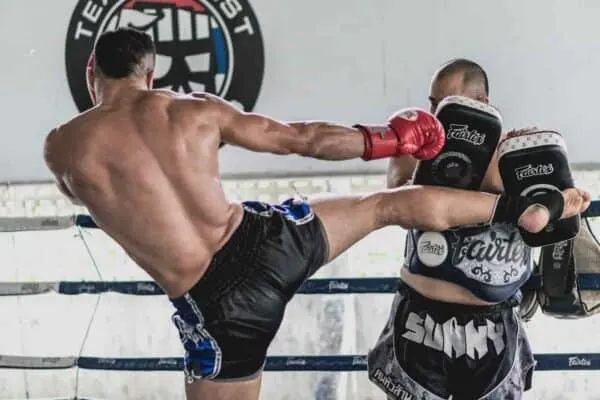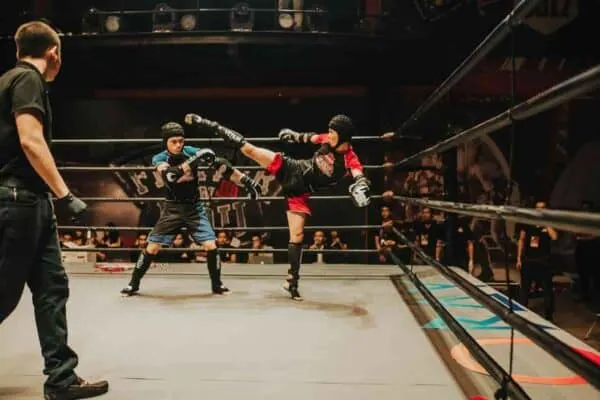
Editor’s note: The views and opinions expressed below are those of the author
Kickboxing has been around for a long time and is practiced by millions worldwide. But many people still wonder: how do you define kickboxing? Is it a sport or a martial art since it’s not clearly defined? Here’s a really short answer:
Kickboxing is primarily a combat sport rather than a martial art because it is geared toward sports competitions and prepares you to win matches and medals. As a result, kickboxing lacks the advanced self-defense training or philosophies found in traditional martial arts.
Are you still perplexed as to why kickboxing can be considered a sport? Well, let me explain to you further why kickboxing is viewed as a sport rather than a martial art!
How You Define Sports?
The definition of “sports” is constantly changing based on standards, social norms, and trends. On paper, sports are competitive athletic activities between two or more parties. The event is organized by the main governing body of the country where the competition takes place.
A sporting event must be hosted according to the official rules, which both sides need to obey. These rules define the way contestants perform, behave, and win or lose matches.
There are various sports categories:
- Single sports where athletes perform alone
- Team sports where a group of people competes against the other group
- Primarily mind sports such as chess
- Primarily physical sports such as rugby
- Single events, tournaments, or leagues
- No contact or full contact
- Motorized or animal-supported
To be considered a sport, an organized activity has to aim to:
- Improve physical and mental health
- Has a strong community and forms relationships
- Obtain results in competition
- Does not put anyone’s life at risk
- Provide fun to spectators
- Promotes strong values
With the term “sports” defined, let’s take a closer look at how kickboxing fits all these requirements.
Is kickboxing a sport?
Kickboxing is a real sport, just like football, boxing, or rugby. It isn’t as popular as some others, but it is a real sport. It meets all the criteria and requirements, or at least most requirements.
- Strong competition community? — Yes
- Entertainment value — Yes
- Improves mental and physical health — Yes
- Promote strong values — Yes
- Encourages fair play and respectful behavior — Yes
- Puts players’ life at risk? — Disputable
In the 1950s, the boxing promoter, Osamu Noguchi, created “kickboxing” as a mix of Muay Thai and karate. The early events were an instant success as they further fired up the rivalry between these two martial arts. Soon after, Noguchi founded the first sanctioning body, the “Kickboxing Association,” in 1966.
In modern times, kickboxing is legal and regulated in just about every country in the world. Each of these countries has its own governing body responsible for hosting the events. Therefore these events are regulated based on specific countries’ official rules and standards to be safe and fair for the players.
Depending on the promotion, kickboxing events could be:
- Tournaments like K-1
- Single matches like in GLORY Kickboxing.
- Leagues at the amateur level.
Last but not least, kickboxers are among the physically and mentally most prepared athletes. Most of them are also good role models and focused on portraying themselves, their team, and sports in a positive way.
What is considered a martial art?
Martial art is a form of art. It aims to improve not just your self-defense abilities but other aspects of your life as well. So, yes, learning valuable self-defense tactics is important. But building character and overcoming oneself through hard training is as important.
There are many types of martial arts and sub-groups that all emphasize different aspects:
- Armed, unarmed or both
- Self-defense, law enforcement, and military
- Personal and spiritual development
- Physical and mental health
- Full-contact, semi-contact, light-contact, no contact
A combat practice must meet all or most of the following criteria to be considered a martial art.
- To be designed for self-defense and real fighting
- Include testing and competition
- Include strict hierarchy and rankings
- Has long-lasting history and tradition
- Encourages spiritual growth through different practices
- Standardized methods of training
- Embraces respectful behavior and high discipline
- Trains you to utilize martial arts skills only to defend yourself
Is kickboxing considered a martial art?
There is a strong argument that kickboxing could be seen as a legitimate martial art where competition is an integral part. But the main problem with kickboxing being a martial art is kickboxing’s lack of philosophy and approach. Unlike most martial arts, kickboxing emphasizes aggression, damage, winning titles, money, and fame, which are not the values real martial arts stand for.

In its initial form, kickboxing was a mix of karate and Muay Thai rules. But it wasn’t created as a martial art like karate or Aikido. No, right from the start, kickboxing was all about competition. It stood as a platform where fighters from various striking arts could compete against each other under hybrid rules.
In training, students do not have to wear a uniform, learn about history and tradition, or embrace its philosophies. Though rankings exist on paper, most kickboxing schools do not have belt ranks. Instead, the classes are split between amateur and pro groups, and that’s it.
Kickboxing training supports personal growth and overcomes oneself. But not directly through methods of training such as breathing exercises and forms of meditation as you often see in traditional martial arts.
Why do people think kickboxing is real martial art?
Here is a list of reasons why kickboxing can be considered a martial art:
- Highly effective for self-defense. Even more than most “real” martial arts
- Improves physical and mental health
- Some organizations include belt ranks
- Supports personal growth (not through philosophies)
- Techniques and training are standardized
- Includes both amateur and pro-competition
What are the Different Types of Kickboxing?
Modern kickboxing has a few different styles that are defined by different sets of rules and competition formats. Here is a look at the four major styles:

- Dutch style — emerged in the 1970s in the Netherlands. The Dutch style is a boxing-heavy style as it puts a lot of emphasis on western boxing combos, and kicks that originate from karate.
- American style (Full Contact Kickboxing)— emerged in the 1970s in the US. American style differs from other styles as all contestants must wear long trousers. Also, the emphasis is on high kicks as kicking below the waist is not allowed.
- K-1 style — is an organization founded in 1993. This is actually a set of rules and competition format used by the K-1 promotion. But it became so popular that in modern times people see it as a separate style. It enables athletes to punch and kick both upper and lower body segments, and strike with knees.
- Japanese style — is the initial style of modern kickboxing developed in the 1950s. It is often seen as the most technical style and a hybrid mix of karate and full contact rules.
RELATED: What are the Different Styles of Kickboxing? Simply Explained
Is Kickboxing effective in self-defense?
Kickboxing is an excellent form of self-defense. The concept of training and teaching methods are in line with the type of fighting situation you may encounter on the streets. It is a full-contact style that will teach you all about the physical and mental aspects of real fighting and how to act when your life is in danger.
In training, each technique you learn works in real life and may help you get out of trouble. It may seem complex at first glance, but mixing kicks and punches is not that hard. The entire system focuses on direct kicks and punches that do not require much energy or time to execute but, at the same time, cause a lot of damage.
Above all, what makes it so practical is that each gym puts a lot of emphasis on hard sparring. Yes, this may sound scary. But remember that this is the only way you can learn how to apply the skills in real life. You can’t develop instincts, timing, or reactions without sparring, and kickboxing includes a ton of it.
Is kickboxing good for MMA?
Yes, kickboxing plays a big role in modern MMA, as the entire system fits well within the rules of the sport. Each MMA fighter, whether from wrestling or BJJ, needs to have solid striking skills to cover all the aspects of the sports, and kickboxing is one of the most popular options.
Nowadays, just about every UFC top fighter or champion has some kickboxing background. Some of the most popular ones are Israel Adesanya, Alex Pereira, and Charles Oliveira.
The only major downside is the fact that the system is quite one-dimensional. It won’t teach you how to fight inside the clinch, use elbows and knees, or how to grapple.
How long does it take to become good at kickboxing?
Students with an average talent for sports who attend the classes at least three times a week could expect to develop solid skills in around two years. But the exact time it takes is based on various factors, such as the quality of the coaching staff, your athletic level, and your aptitude level.
When it comes to learning techniques, in general, kickboxing falls into the group of “easier” sports to learn. Training revolves around five different kicks and punching combos and how to mix them with footwork, angles, and blocks.
In the opening six months, the focus is on improving fitness and fundamentals and becoming more flexible. Students spend most of the time learning and perfecting the basics on the heavy bag or pads or doing live drills. After six months, they learn to apply basic techniques in a light sparring session against the training partner.
After around 1.5-2 years of total training, students may expect to develop good enough skills to start competing in amateur matches. This is also a stage where they are capable of applying kickboxing techniques in a real fight.
However, kickboxing imposes a certain risk to your health. Due to heavy sparring, minor and severe limb and head injuries are a regular occurrence. One study has shown that the rate of injuries is 40 per 1000 minutes of playing time, which is high.
Does Kickboxing include regular boxing techniques?
Yes, the punching techniques and combos utilized by kickboxers are very much the same as those in boxing. Still, remember that boxers are more technical and advanced at punching. Also, there is a slight difference in how athletes execute these techniques as these are two separate sports.
Boxers have a wide stance and heavily lean on their lead leg. They can do this because they won’t be kicked in the leg during a fight. The lack of kicks opens up a wide variety of ways you can attack with punches using different angles, combos, etc.
However, kickboxers must be careful with their hands and how much they lean on the lead leg because they can get blasted with a hard kick at any moment. Kickboxers use boxing techniques but usually use basic boxing strikes such as jabs and hooks to set up powerful kicks and manage their distance.
Are there belts in kickboxing?
Yes, there is a belt ranking system, very much the same as the one in karate in terms of color and number of belts. But bear in mind that the kickboxing belt ranking system is not standardized globally. Or in other words, belt ranks and the way students progress through each rank differ significantly between the organizations and schools.
Within each belt rank, there are stripes (additional degrees) that represent small milestones within the rank. Stripes are given based on knowledge, consistency, and dedication.
Here is the belt order in Kickboxing(if applicable):
- White
- Yellow
- Orange
- Purple
- Blue
- Green
- Brown
- Black belt
It’s worth pointing up that having belt ranking systems is not a common practice in modern times. Therefore, you will rarely find a kickboxing school that utilizes a ranking system, especially in the western world.
What is the key difference between kickboxing and boxing?
Here are all the major differences between kickboxing and boxing:
| Kickboxing | Boxing | |
| History | Modern kickboxing emerged in the 1950s and its founder was the boxing promoter, Osamu Noguchi. | Boxing is one of the oldest combat sports that has been around since ancient times. It first appeared at the 23rd Olympiad in 688 BC. |
| Concept and emphasis | Kickboxing focuses on mixing hand and leg strikes together with footwork. It is a combat sport where athletes compete to win titles, money and fame. | Boxing focuses only on striking using your hands. It is also a combat sport where athletes compete under strict rules. |
| Techniques allowed | Punches Kicks (high and low) Knee strikes (not in all styles) | Punches |
| Match duration | Kickboxing matches include between 3 and 5 rounds of action. Each round is 3 minutes and there is a 1-minute rest between each round. | Boxing matches have between 4 and 12 rounds (high profile bouts). Each round is 3 minutes, and there is a 1-minute rest between each round. |
| Equipment and gear | Full padding gloves, Kickboxing shorts, Groin cup, Trousers (American style), Shoes (American style) | Full padding gloves, Boxing shorts, Boxing shoes, Groin cup |
| Major organizations and promotions | WAKO, WKA, ISKA | WBA, WBC, WBO, IBF |
What is the difference between Kickboxing and Muay Thai?
Here is a detailed look at all the differences between kickboxing and Muay Thai:
| Kickboxing | Muay Thai | |
| History | Kickboxing emerged in the 1950s in Japan. In the initial form, it was a mix of karate techniques and Muay Thai full-contact rules. | Muay Thai origins come from the military system called “Muay Boran”. The modern form first appeared in the 19th century. |
| Emphasis and concept | Kickboxing is a combat sport that focuses on utilizing punches and kicks together. The emphasis is on speed, technique, and power. | Muay Thai is also a combat sport, but a more brutal one. The emphasis is on throwing each strike with a lot of power, and the main goal is to knock the opponent out. |
| Techniques | Punches, Kicks, Knees (not in all styles) | Punches, Kicks, Elbows, Knees, Clinch fighting, Trips, throws, and sweeps |
| Equipment | Full padding gloves, Shorts, Groin cup, Mouthguard, Trousers (American style), Shoes (American style) | Boxing gloves, Shorts, Groin cup, Mouthguard |
| Major organizations and promotions | WAKO, WKA, ISKA | WBC, W.P.M.F, WTBA |
Final Summary
The most practical answer is that kickboxing is primarily a combat sport that can also be considered a martial art if needed.
Most kickboxing schools are generally oriented toward competition and preparing their students to win matches and medals. Consequently, there is no advanced self-defense training, philosophies, breathing, meditative exercises, or other elements that “real” or traditional martial arts include.
But when it comes to benefits, kickboxing is like any other martial art, and the only difference is the approach. Kickboxing training will improve your self-defense abilities, increase confidence and self-esteem, and become physically and mentally stronger.
